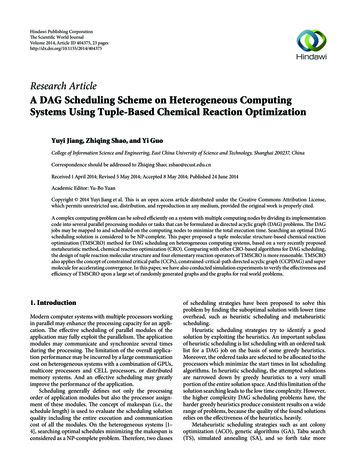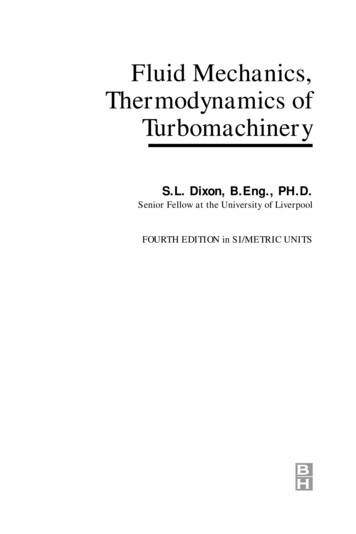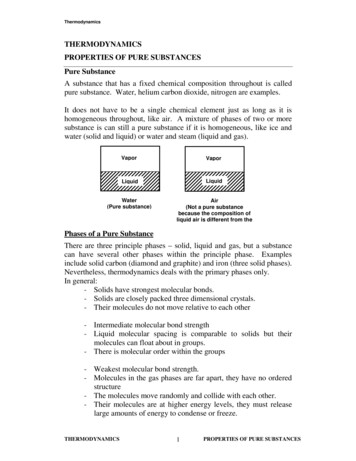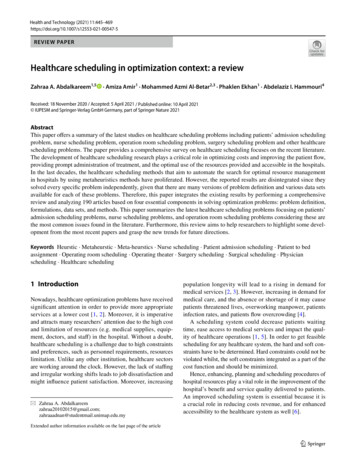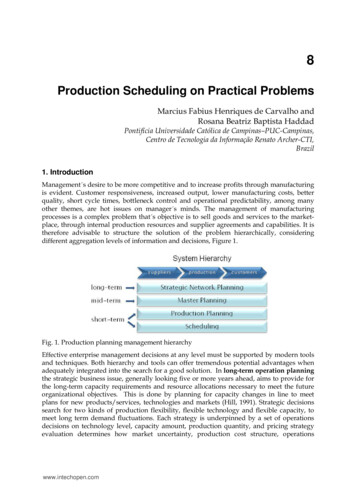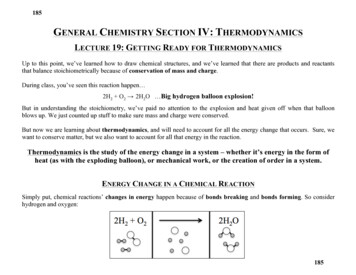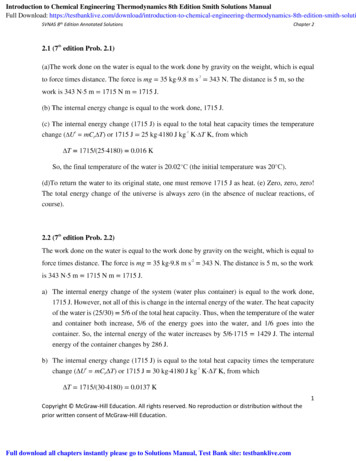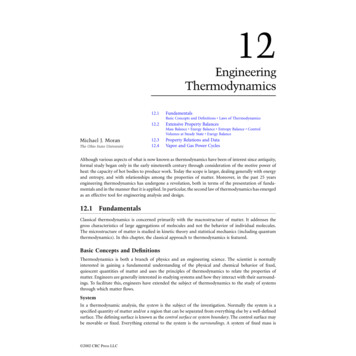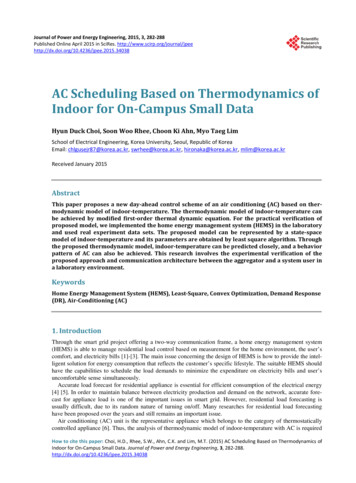
Transcription
Journal of Power and Energy Engineering, 2015, 3, 282-288Published Online April 2015 in SciRes. /10.4236/jpee.2015.34038AC Scheduling Based on Thermodynamics ofIndoor for On-Campus Small DataHyun Duck Choi, Soon Woo Rhee, Choon Ki Ahn, Myo Taeg LimSchool of Electrical Engineering, Korea University, Seoul, Republic of KoreaEmail: chlgusejr87@korea.ac.kr, swrhee@korea.ac.kr, hironaka@korea.ac.kr, mlim@korea.ac.krReceived January 2015AbstractThis paper proposes a new day-ahead control scheme of an air conditioning (AC) based on thermodynamic model of indoor-temperature. The thermodynamic model of indoor-temperature canbe achieved by modified first-order thermal dynamic equation. For the practical verification ofproposed model, we implemented the home energy management system (HEMS) in the laboratoryand used real experiment data sets. The proposed model can be represented by a state-spacemodel of indoor-temperature and its parameters are obtained by least square algorithm. Throughthe proposed thermodynamic model, indoor-temperature can be predicted closely, and a behaviorpattern of AC can also be achieved. This research involves the experimental verification of theproposed approach and communication architecture between the aggregator and a system user ina laboratory environment.KeywordsHome Energy Management System (HEMS), Least-Square, Convex Optimization, Demand Response(DR), Air-Conditioning (AC)1. IntroductionThrough the smart grid project offering a two-way communication frame, a home energy management system(HEMS) is able to manage residential load control based on measurement for the home environment, the user’scomfort, and electricity bills [1]-[3]. The main issue concerning the design of HEMS is how to provide the intelligent solution for energy consumption that reflects the customer’s specific lifestyle. The suitable HEMS shouldhave the capabilities to schedule the load demands to minimize the expenditure on electricity bills and user’suncomfortable sense simultaneously.Accurate load forecast for residential appliance is essential for efficient consumption of the electrical energy[4] [5]. In order to maintain balance between electricity production and demand on the network, accurate forecast for appliance load is one of the important issues in smart grid. However, residential load forecasting isusually difficult, due to its random nature of turning on/off. Many researches for residential load forecastinghave been proposed over the years and still remains an important issue.Air conditioning (AC) unit is the representative appliance which belongs to the category of thermostaticallycontrolled appliance [6]. Thus, the analysis of thermodynamic model of indoor-temperature with AC is requiredHow to cite this paper: Choi, H.D., Rhee, S.W., Ahn, C.K. and Lim, M.T. (2015) AC Scheduling Based on Thermodynamics ofIndoor for On-Campus Small Data. Journal of Power and Energy Engineering, 3, 282-288.http://dx.doi.org/10.4236/jpee.2015.34038
H. D. Choi et al.for efficient load control. The estimation of the indoor-temperature of the next day is essential in order to predictusage of the AC load in private homes.Through the thermal dynamic model [7]-[9] of indoor-temperature, it is possible to estimate the indoor-temperature based on the outdoor temperature information of the following day. Based on the user’s characteristicand estimation of indoor-temperature, the AC scheduling pattern can also be predicted. The indoor-temperatureis also significant information on load shifting or reducing strategy. By providing the indoor temperature information of before and after DR response to consumers, the efficient DR reaction can be led.In this paper, we propose a new day-ahead control scheme of an AC based on a modified thermodynamicmodel of indoor-temperature. There are extensive literatures on the thermal dynamic models of large facilities,however there are limited results in the open literatures on models for residential homes using data of relativelysmall size. Thus, we implemented the HEMS with smart AC in the laboratory and used real experiment data setsfor the validation of the proposed method.2. Day-Ahead Control Scheme for AC Scheduling2.1. Modified Thermodynamic Model of Indoor-TemperatureAs a standard description of thermal dynamics including a residential AC, the discrete-time dynamic equation ofindoor-temperature [7] can be represented as follows:Tin [ k 1] Tin [ k ] α (Tout [ k ] Tin [ k ]) β PAC [ k ] c w [ k ](1)where Tin [ k ] is the indoor-temperature at time [ k ] ; Tout [ k ] is the outdoor-temperature at time [ k ] ; PAC [ k ]is power consumed by AC; and w [ k ] is white Gaussian noise. First, we have performed validation of themodel using real data collected from our laboratory. The collected data includes indoor-temperature, outdoortemperature, and AC power usage. However, the above model did not fit well because the effectiveness of internal thermal noise is simply modeled by constant scalar c. In this paper, in order to give more detailed description for the effectiveness of internal thermal noise, we propose a modified thermal dynamic model for indoortemperature as following form:Tin [ k 1] Tin [ k ] α (Tout [ k ] Tin [ k ]) β PAC [ k ] χ ( γ Tin [ k ])(2)where Tin [ k ] , PAC [ k ] , and PAC [ k ] are defined above and α , β , γ and χ are the model parameters tobe estimated. In this equation, the effectiveness of internal thermal noise is represented by the term of(γ Tin [ k ]) . γ denotes the temperature of internal thermal noise and it needs to be estimated. The differencebetween the temperature of internal thermal noise γ and Tin [ k ] affects the next indoor temperature in theproposed model. Based on the dynamic model in (2), the state-space form of indoor-temperature can be represented asx [ k 1] Ax [ k ] Bu [ k ]y [ k ] Cx [ k ](3)where Tout [ k ] x [ k ] T in [ k ] , u [ k ] PAC [ k ] , 1 A [1 α χ ] , B [α β χγ ] , C 1.(4)As a model fitting method, we use a least-square (LS) algorithm.()2 N Aˆ , Bˆ arg min A, B x [ k 1] ( Ax [ k ] B [ k ]) k 1 (5)where N is the number of observations used in the parameter estimation. In this study, we considered the case283
H. D. Choi et al.when N corresponds to 30 days of measurements. The model extracted from the data needs to be validated usingreal experiment data sets. With the estimated parameters α̂ , β̂ , γˆ and χ̂ obtained from data set, we testthe accuracy of the model using a different data set. Based on the state-space model, the prediction of indoortemperature can be obtainedˆ [ k ] Buˆ [k ]xˆ [ k 1] Ax(6)The mean squared Prediction Error (PE) is given by ep1NN xˆ [ k 1] x [ k 1]2(7)k 1The validation of indoor-temperature prediction is given in Section 3.2.2. Optimization Framework for HEMS Based on the Modified Thermodynamic ModelThe residential consumer’s interest is two-fold. One is to minimize residential consumer payment and the otheris the user’s comfort. It is clear that these two objectives can be conflicting in many scenarios. One of the important issues for optimization problem in HEMS is how to select a cost index for user’s comfort. If one canpredict user’s power consumption pattern for next day, cost selection problem becomes easy. Taking this intoconsideration, we can get the cost function to be minimized as follows: JN k 1(σ C [ k ] PPAC[k ] δTˆinr [ k ] Tin [ k ]2)(8)where Tˆinr [ k ] is the prediction of indoor-temperature considering the usual power usage pattern; CP [ k ] isrelectricity price; PAC[ k ] is power consumed by AC; σ and δ are adjusting weight parameters. The firstand second terms of the objective function in (8) denote the total electricity payment amount and the total cost ofuncomfortableness, respectively. As shown in (8), user’s discomfort index becomes simply the distance from thenormal pattern which can be obtained by estimation of indoor-temperature and user’s AC operating guide.Based on the cost function in (8), we can formulate the optimal AC scheduling problem as the following constrained optimization framework:min PAC Js.tˆ [ k ] Buˆ [k ]x [ k 1] AxN(9)Nr0 PAC λ PAC,k 1 k 1 where P is normal AC load based on the prediction indoor-temperature and user’s pattern; λ is load reducrcan be integrated as constraint.tion ratio. As shown in (9), the thermodynamic of indoor-temperature and PACThe optimization variables are the energy consumption scheduling vectors for AC. Given the feasible AC scheduling sets and the model in (3), the goal is to find the best AC scheduling vectors to make the cost minimize.rAC3. Experimental Results3.1. Experiment Setup Environment for Measurement DataFor the practical verification of proposed method, we implemented the HEMS with smart AC in the laboratoryand used real experiment data sets. Figure 1 shows the HEMS setup operated by laptop and micro controllerunit (MCU) in our laboratory environment. The experiment was carried out in the research laboratory in theDepartment of Electrical Engineering at Korea University. This 35 m2 house is designed to represent real livingspace for three people. In our experiment, a smart AC which is possible to communicate with MCU for DR wasused. The MCU consists of SEP 2.0 communication unit, control unit for AC usage, and AC power measuringunit. The HEMS consists of a laptop with Internet connectivity that runs the HEMS program and can be communicated with the smart AC through Korean DR protocols (Open ADR 2.0/SEP 2.0) standard. Detailed specifications of equipment for HEMS in laboratory are shown in Table 1. The loading profile of the smart AC is284
H. D. Choi et al.Figure 1. Layout of HEMS and setup environment.Table 1. Device configuration.LaptopModelProcessorMemoryOSLenovo ThinkPad E5402.20 GHzIntel i7-4702MQ4 GBWindows 7 32 bitMCUModelATmega2560Functioncommunication with Server and ACoperating AC with DR levelCommunicationPerformanceinterface: RS232Ccommunication level: TTLCPU: 8-bit AVRFlash: 256 KBMax operating Frequency : 16MHzSmart ACModelFunctionVoltageCurrentCarrier CPM-A157TGB0Air Conditioner Dehumidifier220 V8.1 Aobtained by MCU measurement data, which has been measured for 30 days in the area where the house is located. In the same manner, MCU has ability to turn on/off AC using its own outputs. Indoor-temperature andhumidity were obtained through the thermostat and outdoor-temperature brought in meteorology. Using thesecollected data, we validate the effectiveness of the proposed prediction approach based on the modified thermodynamic model in Section 3.3.2. Result ValidationIn this section, we present the experiment results and assess the performance of the proposed prediction of indoor-temperature for AC scheduling. Model parameters of thermodynamic model calculated by least square al-285
H. D. Choi et al.gorithm are listed in Table 2. The collected data includes AC load consumption, humidity, indoor-temperatureand outdoor-temperature within a month period from July 1, 2014 to July 31, 2014. We mainly focus on a threedays period due to limited space. After the prediction of next day indoor-temperature, HEMS presents the ACscheduling based on user’s pattern in Table 3. To make the simulation more close to the realistic and show theimpact of accuracy of the parameter fitting, real measurement data of indoor-temperature and model based estimation of indoor-temperature are plotted for a comparison. The real measurement data of outdoor-temperature,real measurement data of indoor-temperature using AC, predictive indoor-temperature using AC based on consumer’s AC usage pattern are shown in Figure 2. Figure 3 shows the PE of indoor-temperature. As shown inFigure 2 and Figure 3, the model-based estimation of indoor-temperature is similar to the measurement data.Forecast of indoor-temperature and AC usage for the next day can be integrated into convex optimizationframework for optimal AC scheduling.Table 2. Paramters.α̂β̂γˆχ̂PAC [ k ] (kWh)0.1176–2.012127.12690.50810.3Table 3. AC operating rule based on predictive indoor temperature and humidity.minimum continuous operation hours20 minutesmaximum continuous operation hours4 hoursmaximum operating time per day8 hoursThe predictive temperature 27 & humidity 70%turn onThe predictive temperature 26 & humidity 70%turn onIndoor temperatureIndoor estimateTemperature ( C)28Indoor real262411.522.533.544.55data (day)Data informationTemperature ( C)30Indoor estimateIndoor realOutdoor real25power on/off2011.522.533.5data (day)Figure 2. Collected data and estimation of indoor-temperature.28644.55
H. D. Choi et al.1.5Prediction error ( C)10.50-0.5-1-1.577.588.5data (day)99.510Figure 3. Prediction error (PE) for indoor-temperature.4. ConclusionIn this paper, we implemented HEMS for day-ahead AC scheduling based on thermodynamic model in a laboratory environment. The AC load forecasting is usually difficult, due to its random nature of turning on/off. Theproposed HEMS estimated indoor-temperature based on the modified thermodynamic model and used this information to forecast behavior pattern of AC rather than estimating the AC prediction pattern directly. The casestudy of the smart AC provides a closed system which is suitable for demonstration purpose in a laboratory environment. The proposed prediction approach based on the modified thermodynamic model can describe thermal characteristic of indoor-temperature and can be integrated into the optimization framework for optimal ACscheduling. The ideas described in this paper can be extended to address other thermostatically controlled appliances.AcknowledgementsThis work was supported by R&D Program of MOTIE/KEIT, Korea. The authors would like to thank the Ministry of Trade, Industry and Energy, Korea. (No: 10041779, Development of Energy Demand Response Systemfor Smart Home).References[1]Han, D.-M. and Lim, J.-H. (2010) Design and Implementation of Smart Home Energy Management Systems Based onZigbee. IEEE Transactions on Consumer Electronics, 56, 1417-1425. nzo, G.T., Zhu, G., Anjos, M.F. and Savard, G. (2012) A System Architecture for Autonomous Demand SideLoad Management in Smart Buildings. IEEE Transactions on Smart Grid, 3.[3]Mohsenian-Rad, A. and Leon-Garcia, A. (2010) Optimal Residential Load Control with Price Prediction in Real-TimeElectricity Pricing Environments. IEEE Transactions on Smart Grid, 1, [4]Areekul, P., Senjyu, T., Toyama, H. and Yona, A. (2010) A Hybrid ARIMA and Neural Network Model for ShortTerm Forecasting in Deregulated Market. IEEE Transactions on Power Systems, 25.[5]Chen, Y., Luh, P.B., Guan, C., Zhao, Y., Michel, L.D., Coolbeth, M.A., Friedland, P.B. and Rourke, S.J. (2010) ShortTerm Load Forecasting: Similar Day-Based Wavelet Neural Networks. IEEE Transactions on Power Systems, 25, 322330. http://dx.doi.org/10.1109/TPWRS.2009.2030426[6]Li, B. and Alleyne, A.G. (2010) Optimal On-Off Control of an Air Conditioning and Refrigeration System. Proc. Amer.287
H. D. Choi et al.Control Conf., July, 5892-5897.[7]Yu, Z., McLaughlin, L., Jia, L., Murphy-Hoye, M.C., Pratt, A. and Tong, L. (2012) Modeling and Stochastic Controlfor Home Energy Management. Proc. IEEE PES Gen. Meet., July.[8]McLaughlin, L., Jia, L., Yu, Z. and Tong, L. (2011) Thermal Dynamic for Home Energy Management: A Case Study.Cornell Univ., Ithaca, NY, USA, Tech. Rep. ACSP-TR-10-11-01.[9]Quiroga, A., Yu, Z. and Tong, L. (2012) Home Energy Management System Thermal Dynamic Model Fitting. CornellUniv., Ithaca, NY, USA, Tech. Rep. ACSP-TR-09-11-01.288
Carrier CPM-A157TGB0 Air Conditioner Dehumidifier 220 V 8.1 A obtained by MCU measurement data, which has been measured for 30 days in the area where the house is lo-cated. In the same manner, MCU has ability to turn on/off AC using its own outputs. -temperature and Indoor
